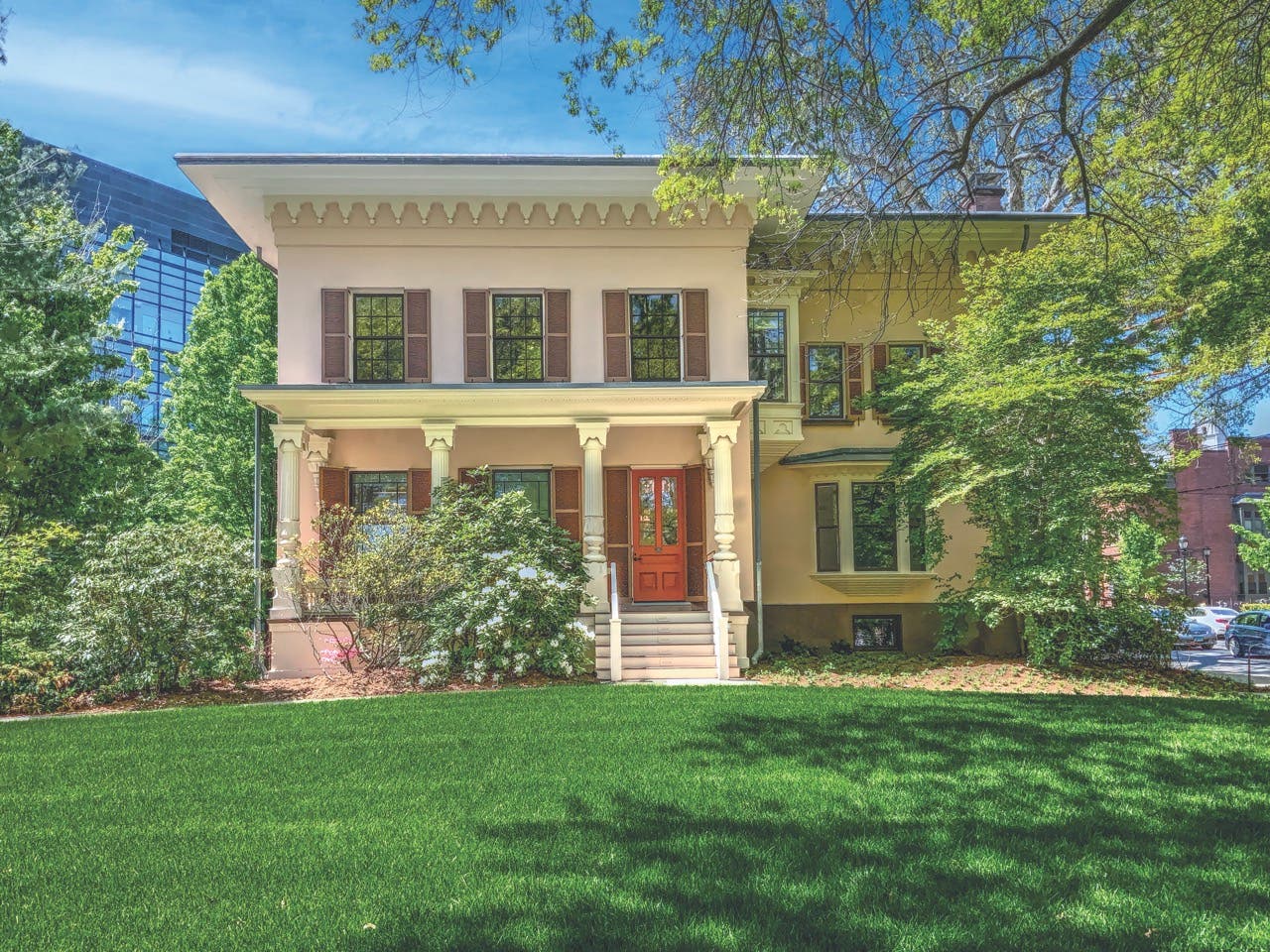
Product Reports
Decorative Painting: Successful Projects in Sacred Settings

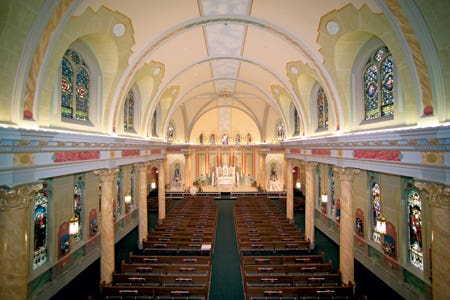


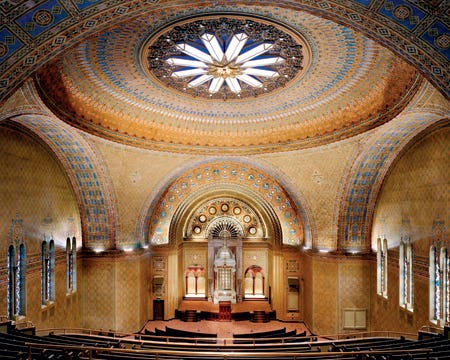
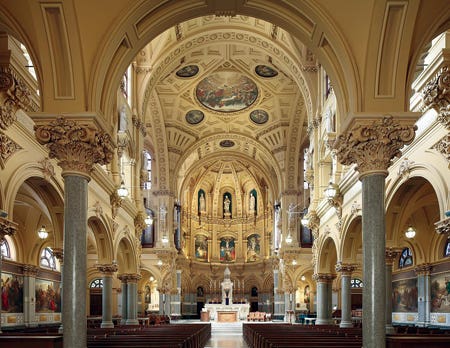
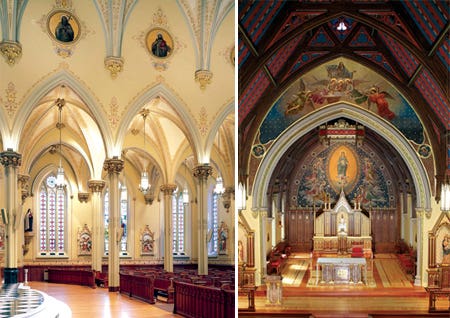
Religious buildings require the highest level of artistry.
By Nancy A. Ruhling
Religious buildings, by their very nature, bring decorative painting to its loftiest level. The sacred and symbolic designs in these spiritual spaces offer a bit of heaven on earth to the God-fearing faithful and present unique challenges and rewards to practitioners of this time-honored craft. The majority of America's churches were built in the 19th century, when immigrants crowded into the country. These newcomers had great faith in God but little understanding of the English language. So churches used architecture and artwork to tell Bible stories in a way that all could understand.
"Historically, the architecture of churches communicated stories of the faith and support of the liturgy through decorative schemes complete with church iconography," says John Canning, principal of Canning Studios
, based in Cheshire, CT. "Today, we are seeing a renewed appreciation of traditions, of symbolism, the importance of color and iconography. I'm excited about this important trend toward a return to the values of church decoration that supports the liturgy and services being performed."
Through the decades, many of the magnificent murals and faux finishes in these houses of God were erased in the quest for Modernism, leaving it up to today's decorative painters to bring the spaces back to life or reinterpret them. This simplification of decoration was led by the Catholic Church in the wake of decrees of the Second Vatican Council in the early 1960s.
The Art of Church Decoration
"Church decoration represents a higher caliber of workmanship than that in other types of buildings," says Canning. "It is some of the best workmanship in the world. I often visit churches instead of art museums." Canning, who established his firm in the 1970s after serving a five-year apprenticeship as a church decorator in his native Scotland, has worked on a variety of projects ranging from the iconic Trinity Church in Boston, MA, which was originally decorated by John La Farge, and the Shrine of Our Lady of Guadalupe, a new basilica in La Crosse, WI, designed by Duncan G. Stroik.
The whitewashing, adds Ray Tiedemann Jr., owner and president of the North Arlington, NJ-based John Tiedemann that was founded by his grandfather in 1954, has covered up artwork by some important artists. "Ninety percent of artwork in churches is buried underneath layers of paint," he says. "This is especially true of Catholic churches, which in the 1960s and 1970s took all the artwork out when the new liturgy was introduced." Tiedemann speaks from vast experience. The company has been working with churches for more than 50 years, most of them in the Northeast. Its roster of clients includes St. Paul's Cathedral in Pittsburgh, PA, St. Theresa's in Manhattan and the Cathedral Basilica of the Sacred Heart in Newark, NJ.
The art of religious buildings, says Jeff Greene, president of EverGreene Architectural Arts in Manhattan, should speak to every soul who enters the sacred space. "People go to churches to feel something spiritually," he says. "You have to create an atmosphere that's conducive to the purpose of the building." Greene, who calls religious architecture theatre, says that it's important to ask "why am I moved when I go to this space? What's the common experience and how do I capture it?"
For his company, which was established in 1978, that means helping the congregation determine what it desires. "We're the hands that carry the ideas out," he says. "We ask a lot of questions like ‘what is the mood' and ‘do you want it to feel like home' to determine what they want, and we look through books for inspiration."
Heidi Gruenke Emery, vice president of Conrad Schmitt Studios of New Berlin, WI, a company that was founded in 1889 and has been in her family since 1953, says that it's important to keep in mind that church decoration remains for generations, forming a collective memory for members of the congregation as they recognize life's milestones. "The art is part of their history," she says. "You have to show a respect for the history and beauty of the church."
When it comes to re-creating covered-up murals, black-and-white images often are the only images the painters have to go on. "Sometimes we look at wedding photos that show the decoration," Emery says. "Black-and-white photos won't give us a record of the colors, but we can see dark versus light in the color and gilding."
Canning says that the decorative painter, when creating a new church mural, is often asked to incorporate the patron saint's colors into the design. Adds Greene, whose company has worked on churches from California to New York and includes the Church of Jesus Christ of Latter Day Saints in Salt Lake City, UT, among its clients, "We strive for timelessness and art with a capital A."
Although religious buildings look toward heaven, their budgets invariably are very down to earth, which makes decorative painting, a relatively inexpensive treatment, the most viable and practical solution. Expensive materials like marble can be faux painted without drastically raising funding levels. This is particularly important because many projects are dependent solely upon donations, so red cents, not gilded saints become the priority by necessity.
"Sometimes it's not economically feasible to do the original scheme," says Emery. "We can do things like decrease the amount of gold leaf on the decorative finishes to stay within budget." She says the studio, which has done work for the Basilica of the Sacred Heart at the University of Notre Dame and St. Joseph Cathedral in Sioux Falls, SD, sometimes has had to phase projects in stages over the course of several years. But she points out that the transformative, timeless designs can last for 30 to 50 years.
San Francisco muralist Lynne Rutter, who founded her boutique atelier in 1990, says that it's important to be realistic, adding that a "simple project finished beautifully will give a better result than an overly ambitious one left half finished."
Rutter, who has completed a number of projects in California, including St. James Episcopal Church in Newport Beach, CA, and Congregation Emanu-El in San Francisco, CA, says it's not unusual for funding to tie up projects. "I have one commission that has been on hold for four years," she says. "And that's ok. Some of the cathedrals in Europe took over 200 years to build."
In one case, in a cost-cutting move, parishioners took up paintbrushes and helped Rutter. "The entire project became a community-building adventure," she says. "It wasn't the most efficient way to get the job done, but it was a lot of fun, and the end result means that much more to everyone involved."
Religious buildings also present logistical challenges. Congregations expect services to continue uninterrupted during conservation work and want to keep pews intact while the painting is in progress. Canning recalls that the work at Boston's Trinity Church required a unique scaffolding system that included steel I-beams and a space frame that cantilevered out. In some cases, a scaffold bridge is constructed. "We try to take up only 25% of the pew space," he says.
The John Tiedemann company tackles the issue with its patented self-propelled "Boom" technology developed by the company founder in 1953 when churches couldn't afford costly scaffolding. "We set up in the center aisle," Ray Tiedemann, Jr. says. "With the booms — telescopic lifts — we don't need to move or close off sections of pews."
He points out that the boom has many advantages: In addition to being less expensive and less invasive than conventional scaffolding, it's compact so it can be set up in the church easily; it can be stored when services are being held; it can be set up and taken down and moved in fewer than five minutes; it is lightweight; it can be operated by as few as two workers; and it runs on a standard 15-amp, 110-volt outlet. "We can easily reach ceilings that are 50 to 90 ft. high," he says.
Appropriate Decorative Schemes
Creating appropriate and effective decorative designs require a thorough knowledge not only of religious iconology and symbols but also of each church building's history. "The purpose of church decoration is to support the liturgy of the service and to act as a teaching instrument," says Canning. "It's like a catechism."
Greene says that it's imperative to understand what worship means to the congregation. "Is it a celebration or a contemplation?" he asks, adding that the answer will impact everything from the style of design to color selection. Often, by necessity, the research becomes a collaboration between the decorative painter and the congregation.
Canning says that during one project, where the company created 22 new 18-ft.-high murals for a Gothic church, alterations had to be made to correct an error. "In one mural, we had six vessels filled with water, and someone in the congregation pointed out that he thought there were only five mentioned in the Bible. We checked and five was correct."
Rutter says that many of her church projects must pass muster not only with a design committee but also with the congregation. "They are all watching what we do," she says, "and you can feel that support every moment. During the restoration of St. Francis of Assisi Church in Sacramento, my crew was sent gifts of cookies, notes of support and gratitude. People brought us dinner and invited us to their homes. Every day we worked there, we felt very strongly how much the place meant to the community and how enduring our work would be."
For new projects, the decorative painter is afforded far more creativity. When Canning worked on the Shrine of Our Lady of Guadalupe, his team delved deep into ecclesiastical history to come up with the subtle, symbol-laden starry night design for the interior of the building's dome.
When Our Lady of Guadalupe appeared as an apparition to the Aztec Indian Juan Diego in December 1531, she was wrapped in a star-studded mantle that was turquoise, a color reserved for royalty. "We used that color for the sky," Canning says. "And we had a science center plot the constellation for that date and used key stars in our design. Most people look up and see only a blue ceiling with stars, but there's a deeper meaning — it's the idea that the mantle is protecting the church."
The architecture — of the building and the service — also sets the tone for the decorative painting, Emery says. "You have to be true to the architecture of the space," she says. "The decorative finishes shouldn't detract from the celebration of mass." Canning agrees, adding that "the murals have to be appreciated in part by the architectural space they inhabit."
The architectural cues - the domes that point toward the Almighty and the stained-glass windows that speak to God - are part of a long-forgotten language that today's decorative painter is being asked not only to translate but also to reinvigorate. "High ceilings create a cathedral effect," Greene says. "Thoughts are expanded by the grandeur of the space. You can break the rules if you understand what they mean."
Paint, Greene says, is the ideal medium to "convey and express a plethora of human emotions. It can be used to emphasize the architecture, so you can see how the building was built. A building is a container for ideas; paint imbues it with layers of meaning. If you look at examples of great buildings, you will see deeper and deeper layers in the architecture. Imbuing the interiors of religious buildings with energy and paint is the most expedient way to express things very powerfully and easily. At the end of the day, it's all about breathing some life into the architecture so that all who go in feel it."
He adds that he takes his work on religious buildings very seriously. "It's the penultimate form of expression," he says. "Churches were meant for the arts to come together in service to them. The idea was to build something timeless not of the times."
Select Suppliers



